Matrixes for CCTV cameras. What to pay attention to?
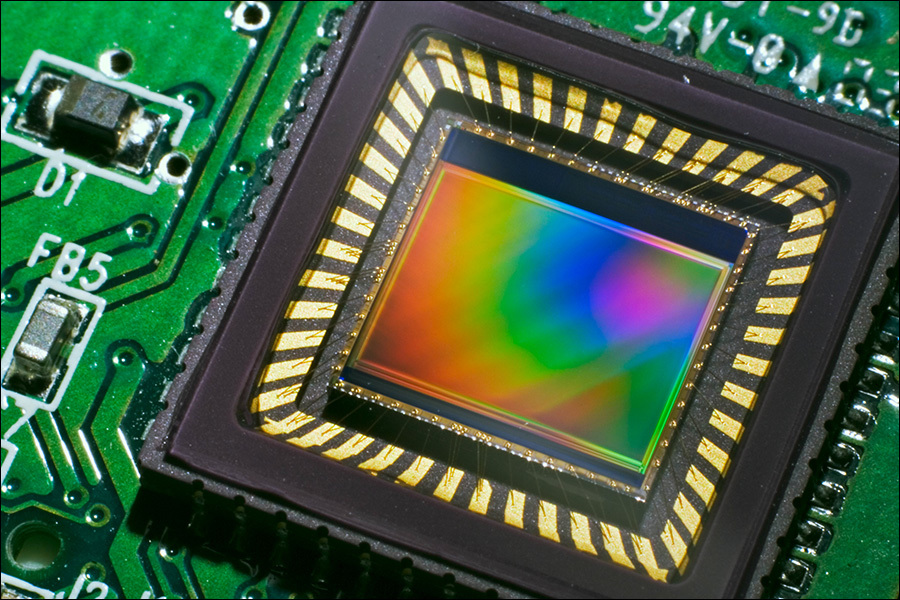
The image quality of a video camera largely depends on the photosensitive sensor (matrix) used in it. After all, put at least the best processor for digitizing video - if a bad image is received on the matrix, it will not become a good one. I will try to popularly explain what you should pay attention to in the characteristics of the video surveillance camera sensor, so that later it would not be painfully painful when you look at the image ...
Type of matrix
On the Internet, you will surely find information that CCD (CCD, charge-coupled device) and CMOS (CMOS, complementary metal-oxide-semiconductor) photosensitive matrices are used in CCTV cameras. Forget it! It has long been only CMOS, only hardcore.
CCD matrixes, with all their merits (better photosensitivity and color rendition, lower noise level), are practically not used in video surveillance. Because the very principle of their operation of CCD matrices - sequential reading of charge across cells is too slow to satisfy the demands of fast, high-resolution video cameras. And the most important thing is that CCD is more expensive in production, and in today's highly competitive environment every penny of profit is on the account. That is why all the key manufacturers focused on the release of CMOS matrices.
It remains to producers, by the way, not so much. The largest, as of the beginning of 2017, are the companies: ON Semiconductor Corporation (which once absorbed the well-known profile company Aptina), Omnivision Technologies Inc., Samsung Electronics and Sony Corporation. In addition, the matrix for their own needs produces, for example, the company Canon, Hikvision.
Competition to old brands is attempting to create young, full of enthusiasm and money Chinese chip makers of the “second echelon”, like SOI (Silicon Optronics, Inc.) and others. It is hard to say whether young growth will survive when the CMOS sensor market becomes saturated and becomes too crowded . But in any case, in this segment the emergence of new players and the aggravation of the struggle are not excluded, after all, it is not too difficult to modernize the production of CMOS sensors by modern standards.
Large global brands like Hikvision or Dahua usually prefer to work with first-tier or own manufacturers of matrices. Local behave differently. For example, Tecsareven in low-cost cameras uses a matrix with a good reputation from ON Semiconductor, Omnivision and Sony. In the assortment of other “popular” brands, for example Berger , SOI sensors, etc. are widely represented.
How to make the matrix of digital cameras
Leadership CMOS
CMOS technology provides for the placement of electronic components (capacitors, transistors) directly in each pixel of the photosensitive matrix.
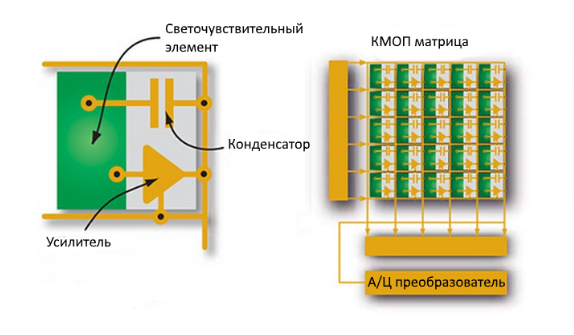
The structure of the pixel and CMOS matrix
This reduces the effective area of the photosensitive element and reduces the sensitivity, plus the active elements increase the level of intrinsic noise of the matrix. But the technology allows the conversion of the charge of a photosensitive element into an electrical signal directly in the matrix and form a digital image signal much faster, which is critical for video cameras. That is why CMOS is better suited for CCTV cameras that require quick frame changes.
The principle of operation of CCD and CMOS matrices.
Plus, the ability to randomly read CMOS matrix cells makes it possible to literally change the quality and bitrate of the resulting video on the fly, which is impossible for CCD. And the power consumption of CMOS solutions is lower, which is also important for compact surveillance cameras.
Let it be color
To obtain a color image, the matrix decomposes the luminous flux into its constituent colors: red, green and blue. To do this, use the appropriate filters. Different manufacturers vary the placement and number of light-sensitive elements of different colors, but the essence does not change.
The principle of image formation on the photosensitive matrix:
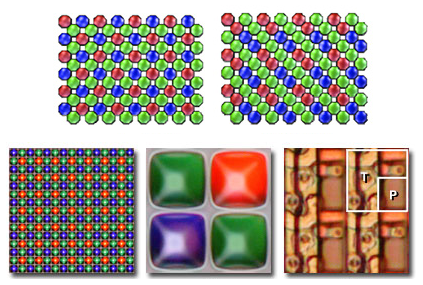
P - photosensitive element
T - electronic components
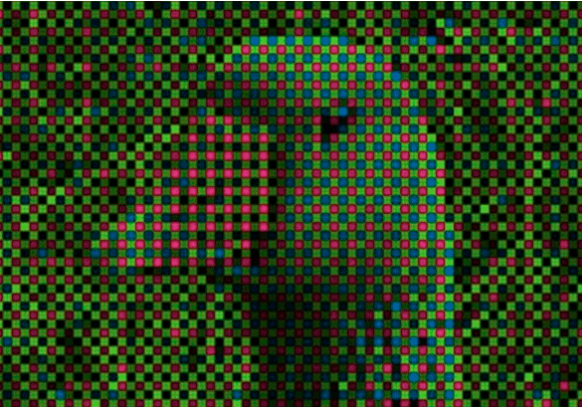
How the CMOS camera sensor works and works can also be viewed on this video from Canon:
CMOS matrices of all manufacturers are based on the above described general principles, differing only in the details of implementation on silicon. For example, in pursuit of cheapness and super-profit, chip makers are trying to produce the matrix as small as possible. Payback for this is inevitable ...
Why big is good. The
standard size (or in other words, format) of a matrix is usually measured diagonally in inches and indicated as a fraction, for example, 1/4 ", 1/3", 2/3 ", 1/2 inch and etc.
The first rule for choosing the best matrix is quite simple: with the same number of pixels (resolution), the larger the physical dimensions of the sensor, the better. The larger matrix has larger pixels, which means it catches more light. The pixels of the larger matrix are less closely spaced, which means less influence of mutual interference and a lower level of spurious noise, which directly affects the quality of the resulting image. Finally, a larger matrix allows for greater viewing angles when using a lens with the same focal length!

Photosensitive matrix produced by ON Semicondactor for video surveillance cameras
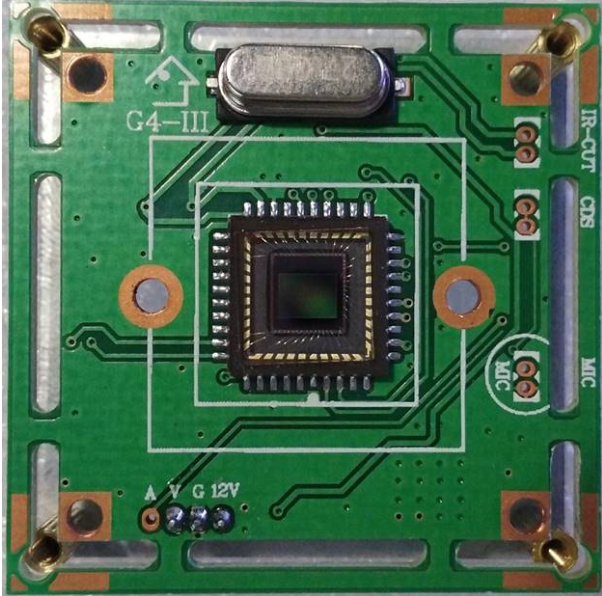
Photosensitive matrix mounted on a video camera board
Alas, large-format matrixes in mass CCTV cameras are now practically not used due to the high cost of both the matrices and the lenses for them, which should have larger lenses and, accordingly, size and cost. Today, cameras are installed mainly in matrix size 1/2 "- 1/4" (this is the smallest). Choosing a camera, you need to clearly understand that buying an ultra-cheap model with a 1/4 "SOI production matrix and a tiny lens with plastic lenses of dubious transparency, you will not be able to create a video control system of acceptable quality that would clearly distinguish small details of the events captured. when shooting in low light conditions.
Choosing a camera with a Sony matrix size 1/8 ”you get a much better video quality a priori, the camera with such a matrix can already be used in a professional video surveillance system. And the sensitivity of such a camera will certainly be higher, which will allow better shooting in weak conditions illumination: in bad weather, at dusk, in a darkened room, etc. With an increase in resolution at the same matrix size, the photosensitivity decreases, and this also needs to be taken into account when choosing. The company commander at the back door, it makes sense to choose a matrix with a lower resolution and higher sensitivity than the ultra-high resolution camera with low sensitivity matrix which due to noise nothing can be plainly discerned.
Sensitivity
The photosensitivity of the matrix determines the possibility of its work in low ambient lighting conditions. From the point of view of physics, this looks quite trite: the less light energy is enough to obtain an image by the matrix, the higher its photosensitivity. But! Let's be frank, it’s not worth pursuing high sensitivity. The fact is that modern video surveillance cameras successfully switch to day / night modes, while reducing illumination, transferring the matrix to a black and white image mode with higher sensitivity. Plus, the automatic activation of the infrared illumination gives the cameras the ability to shoot perfectly even in complete darkness. For example, in a closed room with no windows and with the lights turned off, when there is not even a word about the level of some ambient light. Light sensitivity remains critical for cameras lacking IR illumination, but using such in modern video surveillance is almost a moveton. Although non-backlight hull models are still on sale, of course.
Comparison of matrices of different manufacturers.
In general, the rule is this: the higher the illumination, the better the matrix and, accordingly, the camera will remove. Therefore, it is not recommended to put cameras on half-dark nooks, even if they have good sensitivity. Keep in mind that the specification of the matrix cameras usually indicates the minimum level of illumination, when you can capture at least some image. But no one promises that this image will be at least of acceptable quality! It will be disgusting in 100% of cases, it will be difficult to disassemble anything on it. To achieve at least a satisfactory result, it is recommended to shoot at least at illumination at least 10-20 times greater than the minimum allowable for the matrix.
Manufacturers have come up with a number of technical solutions to improve the sensitivity of CMOS matrices and reduce the loss of light in the process of fixing the image. To do this, basically one principle is used: take out the photosensitive element as close as possible to the microlens of the matrix that collects light. First, Sony proposed its Exmor technology, which shortened the light transmission path in the matrix:
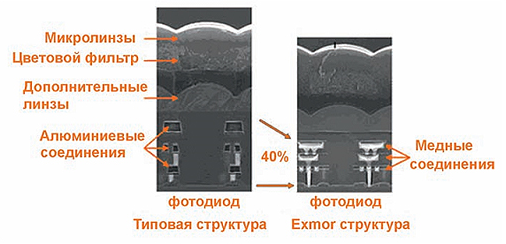
Then progressive manufacturers jointly switched to using reverse-illuminated arrays, which not only reduced the light path through the matrix, but also made the effective area of the photosensitive layer larger items in the cell:

Backlight technology gives the camera maximum sensitivity. From here a conclusion - “with other things being equal” it is better to get a camera using a matrix with a back light, than without it.
In order to improve the image in low-light conditions for low-sensitivity, low-cost arrays, camera manufacturers can use various tricks. For example, the “slow shutter” mode, and more simply, the slow shutter mode. However, the “smearing” of the contours of moving objects already at the stage of fixing the image with a matrix in this mode does not allow talking about a little bit of high-quality video shooting, so this approach is completely unacceptable in security surveillance where details are important.
The appearance of Starlight technology, which first appeared in Bosch cameras in 2012, was a definite breakthrough in image quality. This technology, thanks to the combination of the enormous sensitivity of the matrix (of the order of 0.0001 - 0.001 lux) and the very effective noise reduction technology, made it possible to obtain very high-quality color images from video cameras in low-light conditions and even at night.
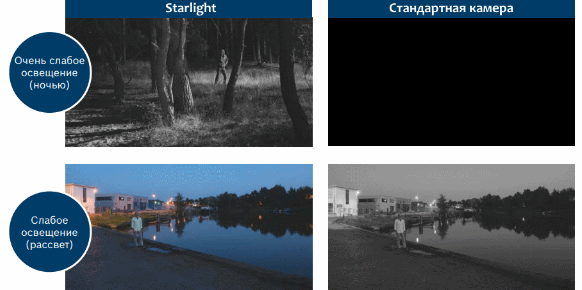
While the traditional way to overcome low light - using IR illumination - allows you to get a clear image only in monochrome mode (shades of gray), cameras with Starlight technology allow you to get a color image that has much more informative. In particular, in low light, the video surveillance system with Starlight technology can easily distinguish the colors of cars, clothes and other important features.
Here is a demonstration of Starlight technology in action:
Results
When choosing a surveillance camera, be sure to pay attention to the characteristics of the matrix, and not just its resolution. After all, this will largely depend on the image quality, and hence the usefulness of the camera. First of all, you should pay attention to a reliable brand, size and resolution of the matrix, the photosensitivity is important only for cameras lacking IR illumination.
I highly recommend taking a camera with a matrix, on which you can find a sane datasheet with detailed information, and not to buy a cat in a bag. For example, you can easily find specifications for matrices manufactured by ON Semiconductor, Omnivision, or Sony. But a little bit of the detailed characteristics of the SOI matrix can not be found during the day with a lantern. There is a suspicion that the manufacturer has something to hide ...
And the overall result is: CMOS matrices have unconditionally won in video surveillance devices and in the near future are not going to give up any competing technology.
